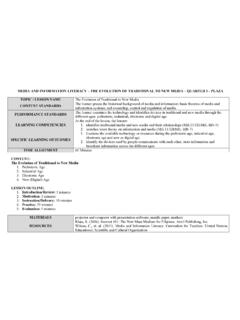Transcription of 2019 update of the EULAR recommendations for the ...
1 736 Fanouriakis A, et al. Ann Rheum Dis 2019 ;78:736 745. update of the EULAR recommendations for the management of systemic lupus erythematosusAntonis Fanouriakis, 1 Myrto Kostopoulou,2 Alessia Alunno, 3 Martin Aringer,4 Ingeborg Bajema,5 John N Boletis,6 Ricard Cervera,7 Andrea Doria, 8 Caroline Gordon,9 Marcello Govoni,10 Fr d ric Houssiau,11 David Jayne,12 Marios Kouloumas,13 Annegret Kuhn,14 Janni L Larsen,15 Kirsten Lerstr m,16 Gabriella Moroni,17 Marta Mosca,18 Matthias Schneider,19 Josef S Smolen,20 Elisabet Svenungsson,21 Vladimir Tesar,22 Angela Tincani,23 Anne Troldborg,24 Ronald van Vollenhoven,25 J rg Wenzel,26 George Bertsias,27 Dimitrios T Boumpas1,28,29To cite: Fanouriakis A, Kostopoulou M, Alunno A, et al.
2 Ann Rheum Dis 2019 ;78:736 editor David S Pisetsky Additional material is published online only. To view please visit the journal online (http:// dx. doi. org/ 10. 1136/ annrheumdis- 2019 - 215089).For numbered affiliations see end of toDr Antonis Fanouriakis, Rheumatology and Clinical Immunology Unit, Attikon University Hospital, Athens 12462, Greece; afanour@ med. uoa. grGB and DTB contributed 18 January 2019 Revised 7 March 2019 Accepted 11 March 2019 Published Online First 29 March 2019 Author(s) (or their employer(s)) 2019 . No commercial re-use. See rights and permissions. Published by objective was to update the EULAR recommendations for the management of systemic lupus erythematosus (SLE), based on emerging new evidence.
3 We performed a systematic literature review (01/2007 12/2017), followed by modified Delphi method, to form questions, elicit expert opinions and reach consensus. Treatment in SLE aims at remission or low disease activity and prevention of flares. Hydroxychloroquine is recommended in all patients with lupus, at a dose not exceeding 5 mg/kg real body weight. During chronic maintenance treatment, glucocorticoids (GC) should be minimised to less than mg/day (prednisone equivalent) and, when possible, withdrawn. Appropriate initiation of immunomodulatory agents (methotrexate, azathioprine, mycophenolate) can expedite the tapering/discontinuation of GC. In persistently active or flaring extrarenal disease, add-on belimumab should be considered; rituximab (RTX) may be considered in organ-threatening, refractory disease.
4 Updated specific recommendations are also provided for cutaneous, neuropsychiatric, haematological and renal disease. Patients with SLE should be assessed for their antiphospholipid antibody status, infectious and cardiovascular diseases risk profile and preventative strategies be tailored accordingly. The updated recommendations provide physicians and patients with updated consensus guidance on the management of SLE, combining evidence-base and lupus erythematosus (SLE) has variable presentation, course and prognosis. The wide acceptance and popularity of the first EULAR recommendations for its management, published in 2008,1 prompted the subsequent development of specific recommendations regarding moni-toring, neuropsychiatric and renal disease, as well as for pregnancy and women s health in 5 Since these publications, new data have emerged on treatment strategies and validated goals of treatment, alternative regimens of glucocorticoids (GC), multitargeted therapy with the use of calci-neurin inhibitors (CNIs) in lupus nephritis (LN), and the approval of the first biological therapy for SLE.
5 These advances called for an update of the EULAR recommendations for lupus, capital-ising on the strengths of and experience from the previous approval by the EULAR Executive Committee, the convenor (DB) and methodolo-gist (GB) invited a Task Force to work on this update ; two fellows (AF, MK) undertook the systematic literature review (SLR). The EULAR standardised operating procedures7 and the Appraisal of Guidelines Research and Evalu-ation instrument (AGREE II)8 were followed. Applying a Delphi-based methodology, 14 research questions were selected for SLR (online supplementary table 1). PubMed was screened using strings of relevant terms.
6 Since this was an update of the previous 2007 recommendations , the SLR considered all English-language publi-cations from 01/2007 until 12/2017, with two exceptions: (1) treatment of skin disease, where an unrestricted date search was performed and (2) renal disease, where search was limited to the period 01/2012 12/2017 (since the EULAR recommendations for LN were published in 2012). Pertinent articles, identified by manual search within the reference list of the originally retrieved publications, were also included. All retrieved items were refined based on article type, abstract, full-text content and number of included patients.
7 The final level of evidence and grading of recommendations considered also the body of evidence that had informed the previous sets of EULAR recommendations for the manage-ment of SLE, as the convenor, methodologist and several of the panellists had also participated in the latter. A detailed presentation of the SLR results is given in online supplementary tables 2 and 3. Evidence was categorised based on the design and validity of available studies and the strength of the statements was graded (see online supplementary table 4). After rounds of discus-sions, the committee reached a consensus of 33 final statements, grouped in four broad cate-gories (Goals of Treatment, Treatment of SLE, Specific manifestations, Comorbidities table 1).
8 Each Task Force member rated their agreement with each statement. on March 6, 2022 by guest. Protected by Rheum Dis: first published as on 29 March 2019 . Downloaded from 737 Fanouriakis A, et al. Ann Rheum Dis 2019 ;78:736 745. 1 recommendations for the management of patients with systemic lupus erythematosusoverarching principles SLE is a multisystem disease occasionally limited to one or few organs diagnosed on clinical grounds in the presence of characteristic serological abnormalities. SLE care is multidisciplinary, based on a shared patient-physician decision, and should consider individual, medical and societal costs. Treatment of organ-threatening/life-threatening SLE includes an initial period of high-intensity immunosuppressive therapy to control disease activity, followed by a longer period of less intensive therapy to consolidate response and prevent relapses.
9 Treatment goals include long-term patient survival, prevention of organ damage and optimisation of health-related quality of of agreement, mean (sd)1. Goals of Treatment in SLE should aim at remission or low disease activity (2b/b) and prevention of flares (2b/b) in all organs, maintained with the lowest possible dose of (0) Flares of SLE can be treated according to the severity of organ(s) involvement by adjusting ongoing therapies (glucocorticoids, immunomodulating agents) to higher doses, switching or adding new therapies (2b/C). ( )2. Treatment of HCQ is recommended for all patients with SLE (1b/A), unless contraindicated, at a dose not exceeding 5 mg/kg/real BW (3b/C). ( ) In the absence of risk factors for retinal toxicity, ophthalmological screening (by visual fields examination and/or spectral domain-optical coherence tomography) should be performed at baseline, after 5 years, and yearly thereafter (2b/b).
10 ( ) GC can be used at doses and route of administration that depend on the type and severity of organ involvement (2b/C). ( ) Pulses of intravenous methylprednisolone (usually 250 1000 mg per day, for 1 3 days) provide immediate therapeutic effect and enable the use of lower starting dose of oral GC (3b/C). ( ) For chronic maintenance treatment, GC should be minimised to less than mg/day (prednisone equivalent) (1b/b) and, when possible, ( ) Prompt initiation of immunomodulatory agents can expedite the tapering/discontinuation of GC (2b/b). ( ) Immunosuppressive In patients not responding to HCQ (alone or in combination with GC) or patients unable to reduce GC below doses acceptable for chronic use, addition of immunomodulating/immunosuppressive agents such as methotrexate, (1b/b) azathioprine (2b/C) or mycophenolate (2a/b) should be ( ) Immunomodulating/immunosuppressive agents can be included in the initial therapy in cases of organ-threatening disease (2b/C).












